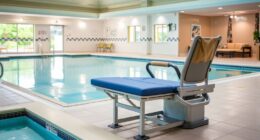Inside large glass domes, sound reflects off surfaces, amplifying noise levels and making it easy to overexpose your ears. To protect your hearing, wear earplugs or earmuffs, especially if loud sounds persist. Limit your time inside and take breaks outside when noise becomes too loud. Using a sound level meter can help you monitor your environment effectively. If you want to learn how to keep your ears safe in such spaces, keep exploring these strategies.
Key Takeaways
- Glass domes reflect sound, amplifying noise and making sound management essential.
- Exposure to noise above 85 decibels can cause hearing damage, requiring protective measures.
- Earplugs and earmuffs reduce sound levels, preventing long-term hearing harm in loud environments.
- Taking breaks and monitoring sound levels help manage noise exposure effectively.
- Awareness of sound reflection effects and using protective gear safeguard hearing health inside glass structures.

Have you ever wondered how loud noise affects your hearing? When you’re in a place with high sound levels, especially inside a large glass dome, your ears are under more stress than you might realize. Continuous exposure to loud noises can damage your delicate hearing cells, leading to temporary discomfort or even permanent hearing loss over time. That’s why understanding noise levels and protecting your ears is essential, particularly in environments where sound can bounce and amplify within glass structures.
High sound levels inside glass domes can harm your hearing—protect your ears to avoid permanent damage.
Glass domes, while visually stunning, can inadvertently increase noise levels. Sound waves reflect off the smooth, hard surfaces, creating echoes that amplify noise rather than dampen it. As a result, what might start as a moderate sound can quickly become overwhelming. If you’re attending an event or working in such an environment, it’s vital to be aware of the noise levels and how they impact your ears. Overexposure to loud sounds, especially above 85 decibels, can lead to hearing fatigue or damage. Think of it like a warning sign: if your ears start ringing or you find yourself shouting to be heard, it’s time to take action.
To manage sound effectively in these settings, ear protection becomes your best ally. Earplugs are a simple and affordable option, fitting snugly to reduce the volume reaching your inner ear. They’re especially useful if you’re sensitive to loud noises or need to spend extended periods inside the dome. Earmuffs offer another layer of protection, covering your entire ear and providing a more substantial barrier against noise. For environments with unpredictable or extremely loud sounds, combining earplugs and earmuffs can offer maximum safety.
It’s also important to be mindful of your environment. If you notice the sound is getting louder or more chaotic, take breaks outside the dome if possible. Giving your ears a rest helps prevent long-term damage. Additionally, paying attention to the duration of your exposure is key; even moderate noise levels can become harmful if you’re exposed for hours on end. Using sound level meters or smartphone apps can help you gauge noise intensity, guiding you on when to don ear protection or step away.
Being aware of sound reflection and how it can amplify noise in glass structures is crucial for protecting your hearing health. Ultimately, managing sound in big glass domes isn’t just about comfort; it’s about safeguarding your hearing health. By understanding the impact of noise, recognizing when to protect your ears, and using appropriate ear protection, you can enjoy your time inside these impressive structures without risking permanent damage. Your ears are valuable, and taking simple steps now can save you from hearing problems later.
Frequently Asked Questions
How Do Noise Levels Vary During Different Times of the Day?
During different times of the day, noise levels fluctuate markedly. In the morning, noise is usually lower as fewer visitors arrive, allowing for a quieter atmosphere. As the day progresses, especially around midday and late afternoon, noise increases with more visitors, activities, and environmental sounds. In the evening, noise levels tend to decrease again as visitors leave and activities wind down, creating a more peaceful environment.
What Materials Are Best for Soundproofing Glass Domes?
You should use materials like acoustic panels, laminated glass, and soundproof curtains for your glass dome. Imagine the contrast: transparent elegance meets dense, sound-absorbing layers that block noise effectively. Laminated glass combines clarity with sound insulation, while acoustic panels inside the dome absorb echoes, creating a peaceful haven. These materials work together to reduce noise transmission, ensuring a quiet, serene environment inside your glass dome.
Are There Specific Regulations for Noise in Public Glass Structures?
Yes, there are specific regulations for noise in public glass structures, which vary by location. You should check local ordinances and building codes to make certain of compliance. These regulations often set acceptable noise levels during certain hours and require soundproofing measures if needed. By staying informed and adhering to these rules, you ensure your structure remains legally compliant and provides a comfortable environment for visitors.
How Does Interior Design Impact Sound Management?
Interior design greatly impacts sound management in glass domes. You can use materials like carpets, acoustic panels, and soft furnishings to absorb sound and reduce echo. Strategically placing furniture and decor helps direct sound away from sensitive areas. Incorporating curved or irregular surfaces breaks up sound waves, preventing loud reflections. By thoughtfully selecting and arranging these elements, you create a comfortable, acoustically balanced space that minimizes noise disruptions.
Can Ear Protection Affect Communication Within the Dome?
Yes, ear protection can affect communication within the dome. When you wear earplugs or noise-canceling devices, they reduce ambient noise, making it harder to hear others clearly. This can lead to misunderstandings or require you to speak louder. To maintain effective communication, use ear protection that balances noise reduction with the ability to hear voices, or consider using hand signals or other non-verbal cues.
Conclusion
If you ignore the noise levels in those massive glass domes, you’re risking more than just a headache—you could be silencing your future. Without proper ear protection, the relentless roar could drown out your dreams, crush your peace, and turn your life into an endless chaos. Don’t let the deafening sound take away your voice. Protect your ears now—because once the noise consumes you, there’s no turning back from the silence you’ll wish you’d fought harder to hear.









